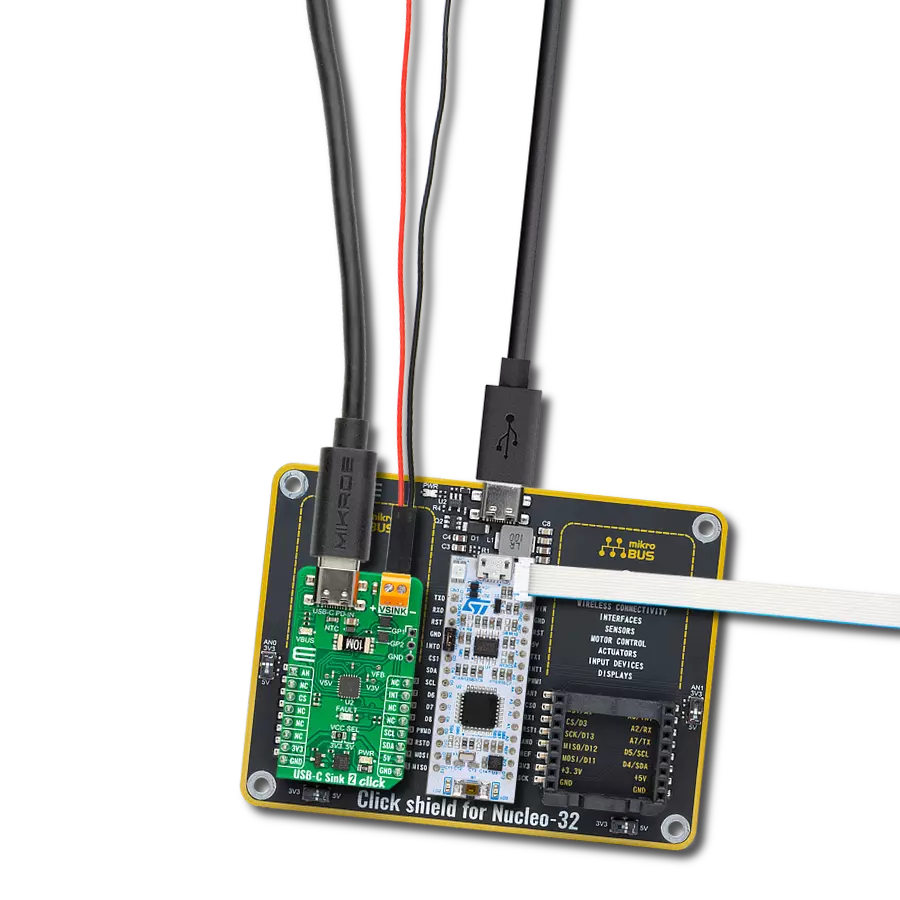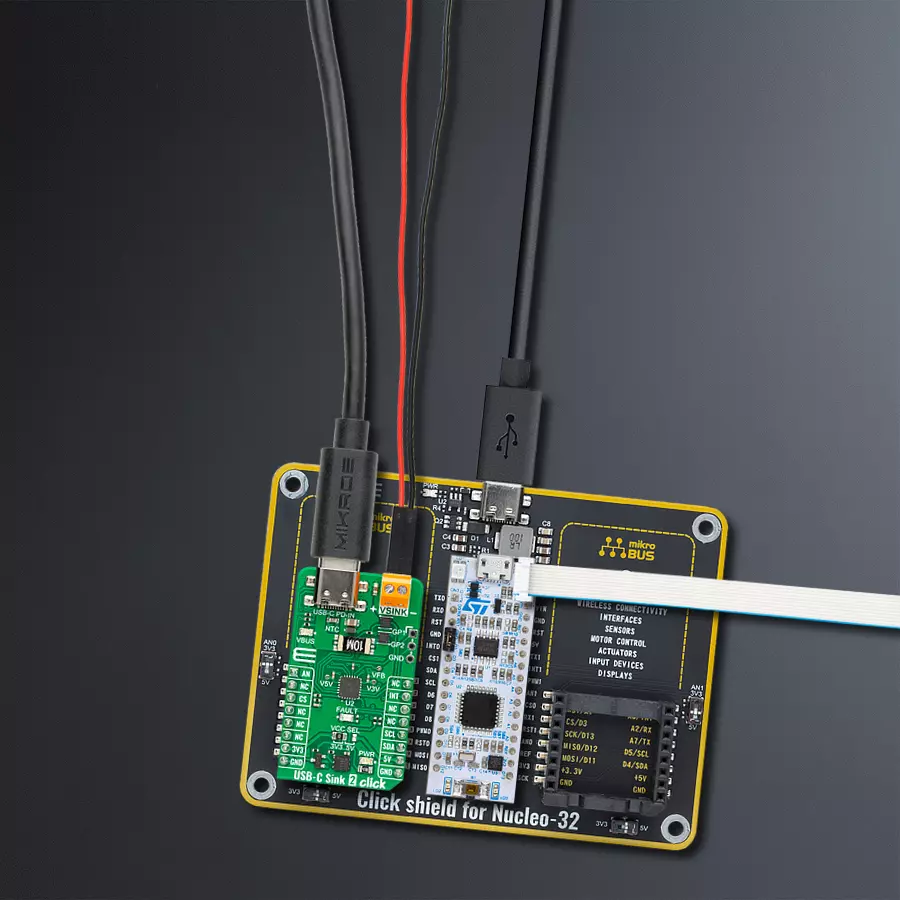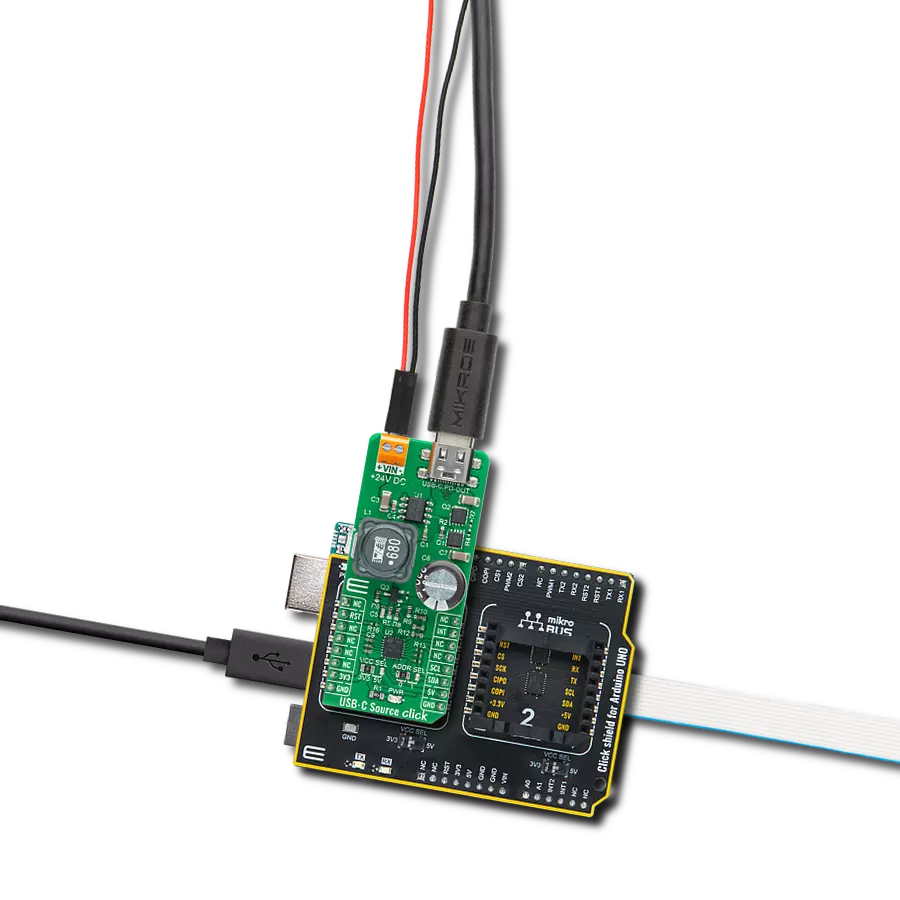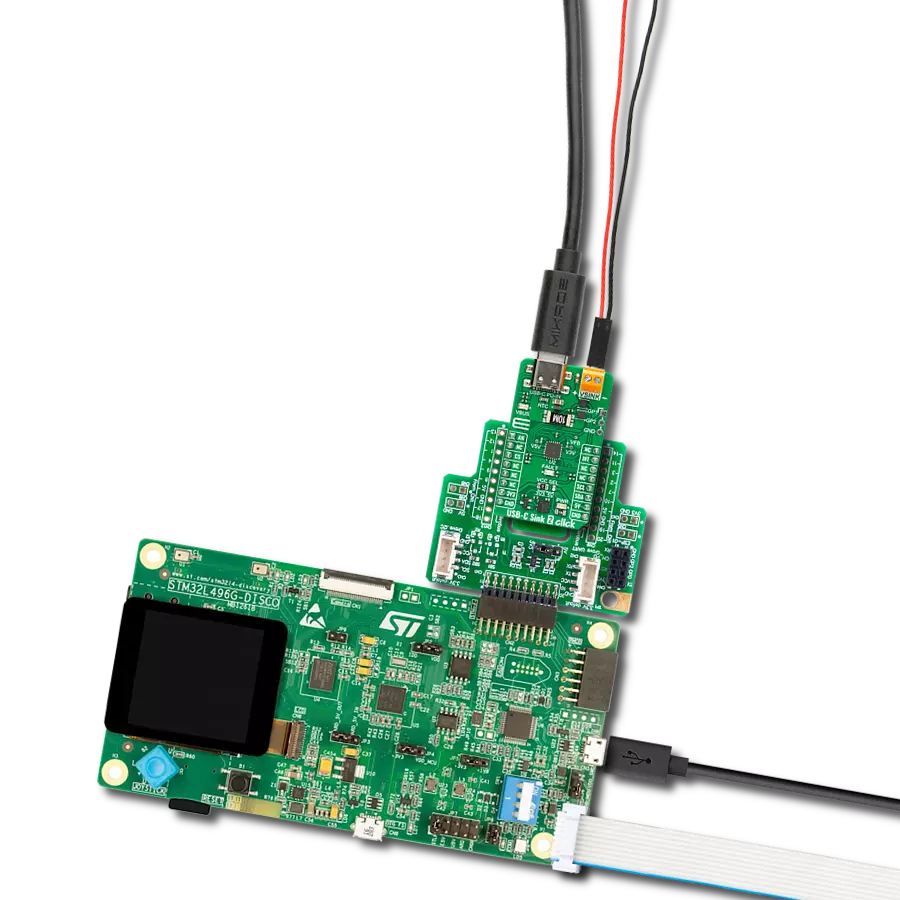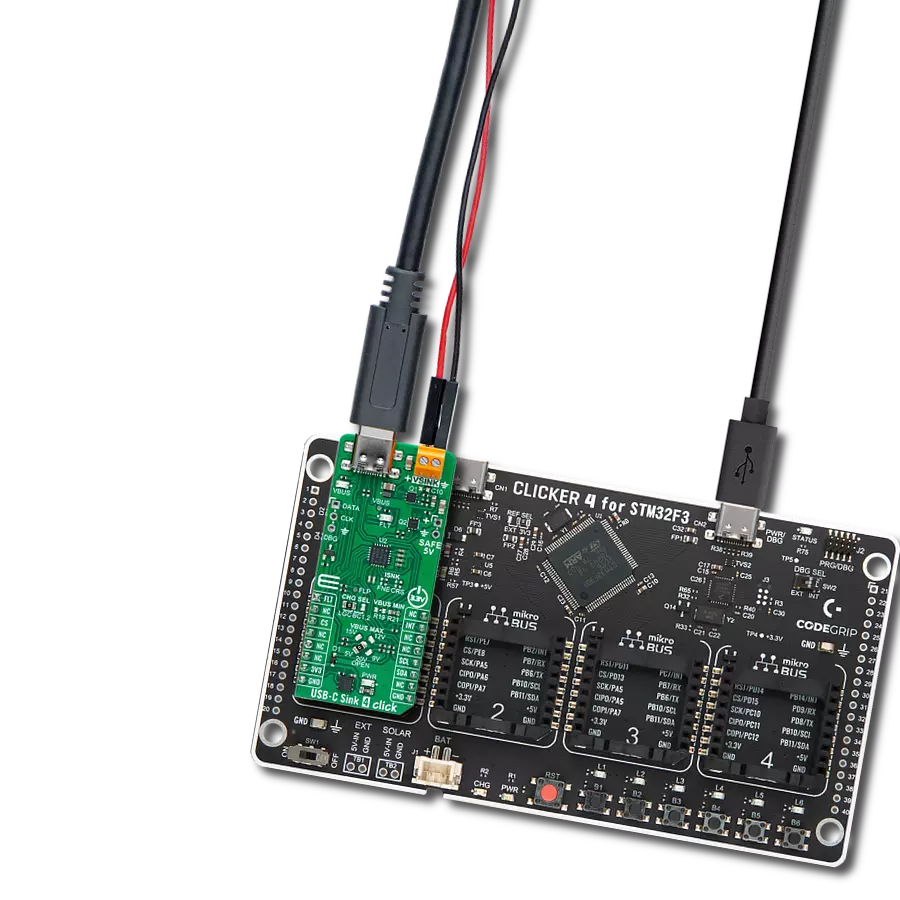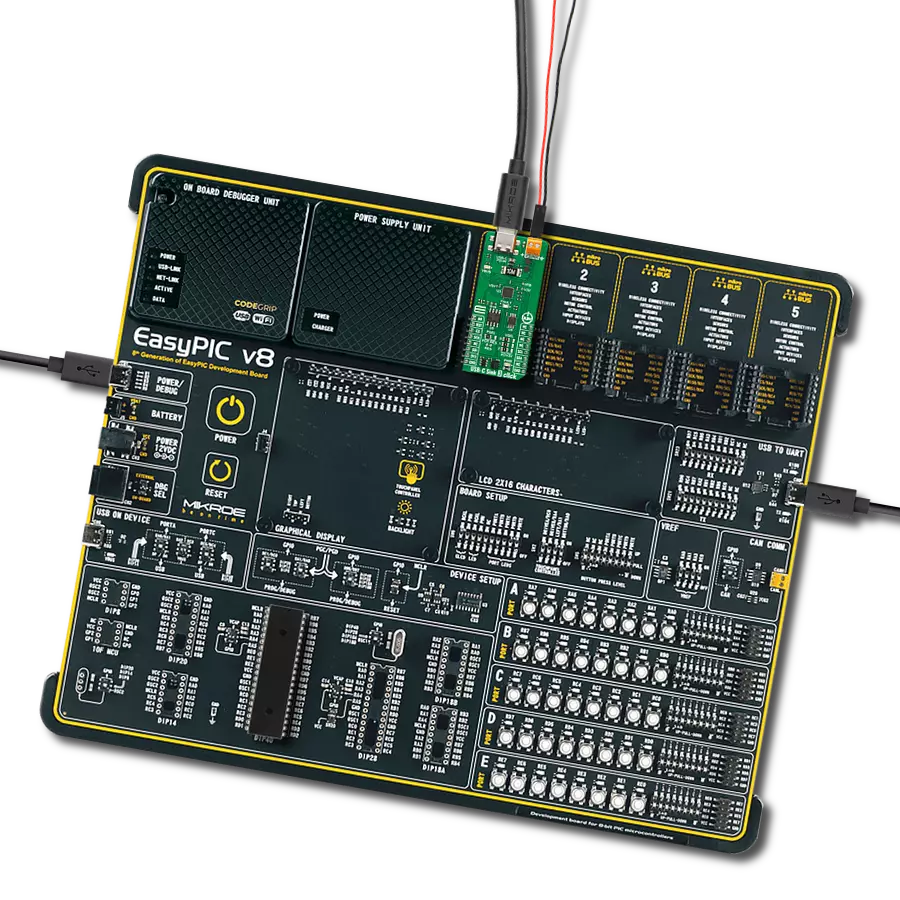Transform the way you connect and charge with our cutting-edge USB-C sink solution, delivering reliability and performance beyond expectations
A
A
Hardware Overview
How does it work?
USB-C Sink 2 Click is based on the AP33772, a high-performance USB PD sink controller from Diodes Incorporated. The host MCU can control the PPS with 20mV/step voltage and 50mA/step current. The PD controller supports overtemperature protection (OTP), OVP with auto-restart, OCP with auto-restart, one-time programming (OTP), power-saving mode, and a system monitor and control status register. For OTP, this Click board™ comes with an NTC temperature sensor, with selectable temperature points (25°C, 50°C, 75°C, 100°C) as a temperature threshold. The onboard FAULT LED serves as a visual presentation of the negotiation mismatch. The Multi-time programming (MTP) is reserved for future configuration. This USB Type-C power delivery sink controller requires power from a
standard USB source adapter, in our case from the USB connector labeled USB-C PD-IN, and then delivers power to connected devices on the VSINK connector. A pair of MOSFETs stands between the USB and VSINK terminal, according to the AP33772 driver for N-MOS VBUS power switch support. The PD controller can control the external NMOS switch ON or OFF (all control is done via the I2C interface). The USB C connector acts as a PD-IN discharge path terminal with a USB Type-C configuration channels 1 and 2. The presence of the power supply on the USB C is indicated over the VBUS LED. The AP33772 is equipped with several GPIOs. The user-configurable GPIO1 and GPIO2 are available on the side header labeled GP1 and GP2, with additional GND. Also, this Click board™ has several test pads for testing
purposes. The 5V and 3.3V LDO voltage output can be measured over the V5V and V3V pads and voltage feedback over the VFB pad. USB-C Sink 2 Click uses a standard 2-Wire I2C interface to communicate with the host MCU. The interrupts from AP33772 can be monitored over the INT pin. One of the additional features of the USB-C Sink 2 Click is the ability to track the VBUS voltage over the AN pin of the mikroBUS™ socket. This Click board™ can operate with either 3.3V or 5V logic voltage levels selected via the VCC SEL jumper. This way, both 3.3V and 5V capable MCUs can use the communication lines properly. Also, this Click board™ comes equipped with a library containing easy-to-use functions and an example code that can be used as a reference for further development.
Features overview
Development board
Nucleo 32 with STM32F031K6 MCU board provides an affordable and flexible platform for experimenting with STM32 microcontrollers in 32-pin packages. Featuring Arduino™ Nano connectivity, it allows easy expansion with specialized shields, while being mbed-enabled for seamless integration with online resources. The
board includes an on-board ST-LINK/V2-1 debugger/programmer, supporting USB reenumeration with three interfaces: Virtual Com port, mass storage, and debug port. It offers a flexible power supply through either USB VBUS or an external source. Additionally, it includes three LEDs (LD1 for USB communication, LD2 for power,
and LD3 as a user LED) and a reset push button. The STM32 Nucleo-32 board is supported by various Integrated Development Environments (IDEs) such as IAR™, Keil®, and GCC-based IDEs like AC6 SW4STM32, making it a versatile tool for developers.
Microcontroller Overview
MCU Card / MCU

Architecture
ARM Cortex-M0
MCU Memory (KB)
32
Silicon Vendor
STMicroelectronics
Pin count
32
RAM (Bytes)
4096
You complete me!
Accessories
Click Shield for Nucleo-32 is the perfect way to expand your development board's functionalities with STM32 Nucleo-32 pinout. The Click Shield for Nucleo-32 provides two mikroBUS™ sockets to add any functionality from our ever-growing range of Click boards™. We are fully stocked with everything, from sensors and WiFi transceivers to motor control and audio amplifiers. The Click Shield for Nucleo-32 is compatible with the STM32 Nucleo-32 board, providing an affordable and flexible way for users to try out new ideas and quickly create prototypes with any STM32 microcontrollers, choosing from the various combinations of performance, power consumption, and features. The STM32 Nucleo-32 boards do not require any separate probe as they integrate the ST-LINK/V2-1 debugger/programmer and come with the STM32 comprehensive software HAL library and various packaged software examples. This development platform provides users with an effortless and common way to combine the STM32 Nucleo-32 footprint compatible board with their favorite Click boards™ in their upcoming projects.
Used MCU Pins
mikroBUS™ mapper
Take a closer look
Click board™ Schematic
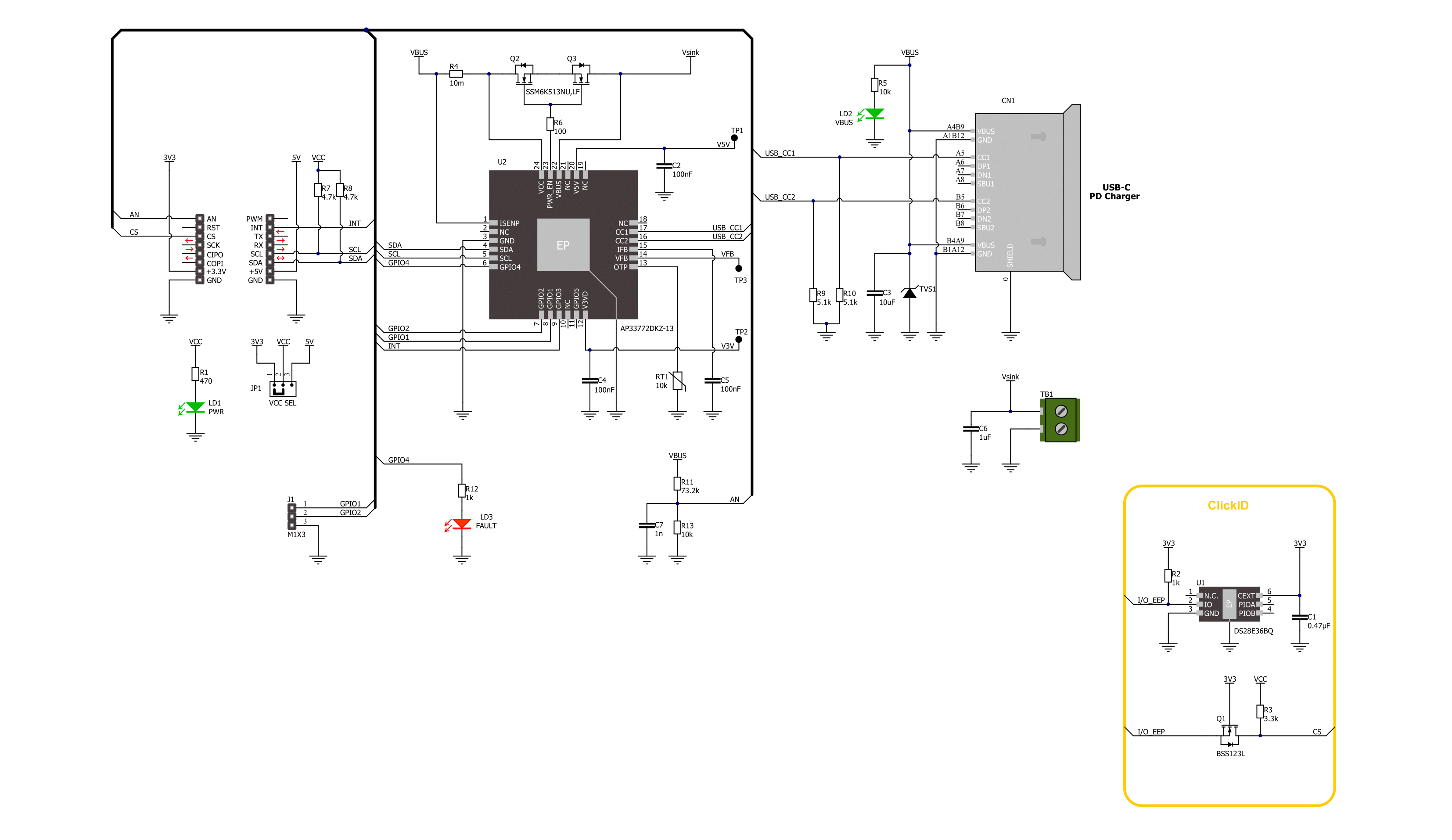
Step by step
Project assembly
Software Support
Library Description
This library contains API for USB-C Sink 2 Click driver.
Key functions:
usbcsink2_write_rdo- USB-C Sink 2 write the RDO function.usbcsink2_get_pdo_voltage- USB-C Sink 2 get the voltage function.usbcsink2_get_pdo_current- USB-C Sink 2 get the current function.
Open Source
Code example
The complete application code and a ready-to-use project are available through the NECTO Studio Package Manager for direct installation in the NECTO Studio. The application code can also be found on the MIKROE GitHub account.
/*!
* @file main.c
* @brief USB-C Sink 2 Click Example.
*
* # Description
* This example demonstrates the use of the USB-C Sink 2 Click board™
* by setting DC power requests and control for Type-C connector-equipped devices (TCD).
*
* The demo application is composed of two sections :
*
* ## Application Init
* Initializes I2C and ADC modules and log UART.
* After driver initialization the app set default settings.
*
* ## Application Task
* In this example, the app configures Power Data Objects (PDO)
* highest priority profile and requests power from a standard USB PD source adapter.
* After connecting the PD source and USB-C Sink 2 Click with the Type-C cable,
* the app gets the total number of valid PDO's
* and switches all PDO configurations every 10 seconds.
* When the PD source accepts the request, the app displays information about
* VOUT Voltage [mV] and Current [mA] and the temperature [degree Celsius] of the USB-C connector.
*
* @note
* FAULT LED flickering notified of the system status:
* - Charging: Breathing light (2 sec dimming), 1 cycle is 4 sec.
* - Fully charged: Continuously lit Charging current < 500mA.
* - Mismatch: 1s flicker Voltage or power mismatch. Non-PD power source, 1 cycle is 2sec.
* - Fault: 300ms flicker OVP, 1 cycle is 600ms.
*
* @author Nenad Filipovic
*
*/
#include "board.h"
#include "log.h"
#include "usbcsink2.h"
static usbcsink2_t usbcsink2; /**< USB-C Sink 2 Click driver object. */
static log_t logger; /**< Logger object. */
void application_init ( void )
{
log_cfg_t log_cfg; /**< Logger config object. */
usbcsink2_cfg_t usbcsink2_cfg; /**< Click config object. */
/**
* Logger initialization.
* Default baud rate: 115200
* Default log level: LOG_LEVEL_DEBUG
* @note If USB_UART_RX and USB_UART_TX
* are defined as HAL_PIN_NC, you will
* need to define them manually for log to work.
* See @b LOG_MAP_USB_UART macro definition for detailed explanation.
*/
LOG_MAP_USB_UART( log_cfg );
log_init( &logger, &log_cfg );
log_info( &logger, " Application Init " );
// Click initialization.
usbcsink2_cfg_setup( &usbcsink2_cfg );
USBCSINK2_MAP_MIKROBUS( usbcsink2_cfg, MIKROBUS_1 );
err_t init_flag = usbcsink2_init( &usbcsink2, &usbcsink2_cfg );
if ( ( ADC_ERROR == init_flag ) || ( I2C_MASTER_ERROR == init_flag ) )
{
log_error( &logger, " Communication init." );
for ( ; ; );
}
if ( USBCSINK2_ERROR == usbcsink2_default_cfg ( &usbcsink2 ) )
{
log_error( &logger, " Default configuration." );
for ( ; ; );
}
log_info( &logger, " Application Task " );
log_printf( &logger, "---------------------------\r\n" );
Delay_ms ( 100 );
}
void application_task ( void )
{
static float voltage_mv = 0, current_ma = 0;
static uint8_t temperature = 0;
for ( uint8_t pdo_num = 0; pdo_num < usbcsink2.number_of_valid_pdo; pdo_num++ )
{
usbcsink2.pdo_data[ pdo_num * 4 + 3 ] = ( pdo_num + 1 ) << 4;
if ( USBCSINK2_OK == usbcsink2_write_rdo( &usbcsink2, &usbcsink2.pdo_data[ pdo_num * 4 ] ) )
{
log_printf( &logger, " --- PDO[ %d ] ---\r\n", ( uint16_t ) pdo_num );
}
if ( USBCSINK2_OK == usbcsink2_wait_rdo_req_success( &usbcsink2 ) )
{
if ( USBCSINK2_OK == usbcsink2_get_pdo_voltage( &usbcsink2, &voltage_mv ) )
{
log_printf( &logger, " Voltage : %.2f mV\r\n", voltage_mv );
}
if ( USBCSINK2_OK == usbcsink2_get_pdo_current( &usbcsink2, ¤t_ma ) )
{
log_printf( &logger, " Current : %.2f mA\r\n", current_ma );
}
if ( USBCSINK2_OK == usbcsink2_get_temperature( &usbcsink2, &temperature ) )
{
log_printf( &logger, " Temperature : %d C\r\n", ( uint16_t ) temperature );
}
log_printf( &logger, "---------------------------\r\n" );
// 10 seconds delay
Delay_ms ( 1000 );
Delay_ms ( 1000 );
Delay_ms ( 1000 );
Delay_ms ( 1000 );
Delay_ms ( 1000 );
Delay_ms ( 1000 );
Delay_ms ( 1000 );
Delay_ms ( 1000 );
Delay_ms ( 1000 );
Delay_ms ( 1000 );
}
}
}
int main ( void )
{
/* Do not remove this line or clock might not be set correctly. */
#ifdef PREINIT_SUPPORTED
preinit();
#endif
application_init( );
for ( ; ; )
{
application_task( );
}
return 0;
}
// ------------------------------------------------------------------------ END
Additional Support
Resources
Category:USB-C PD
